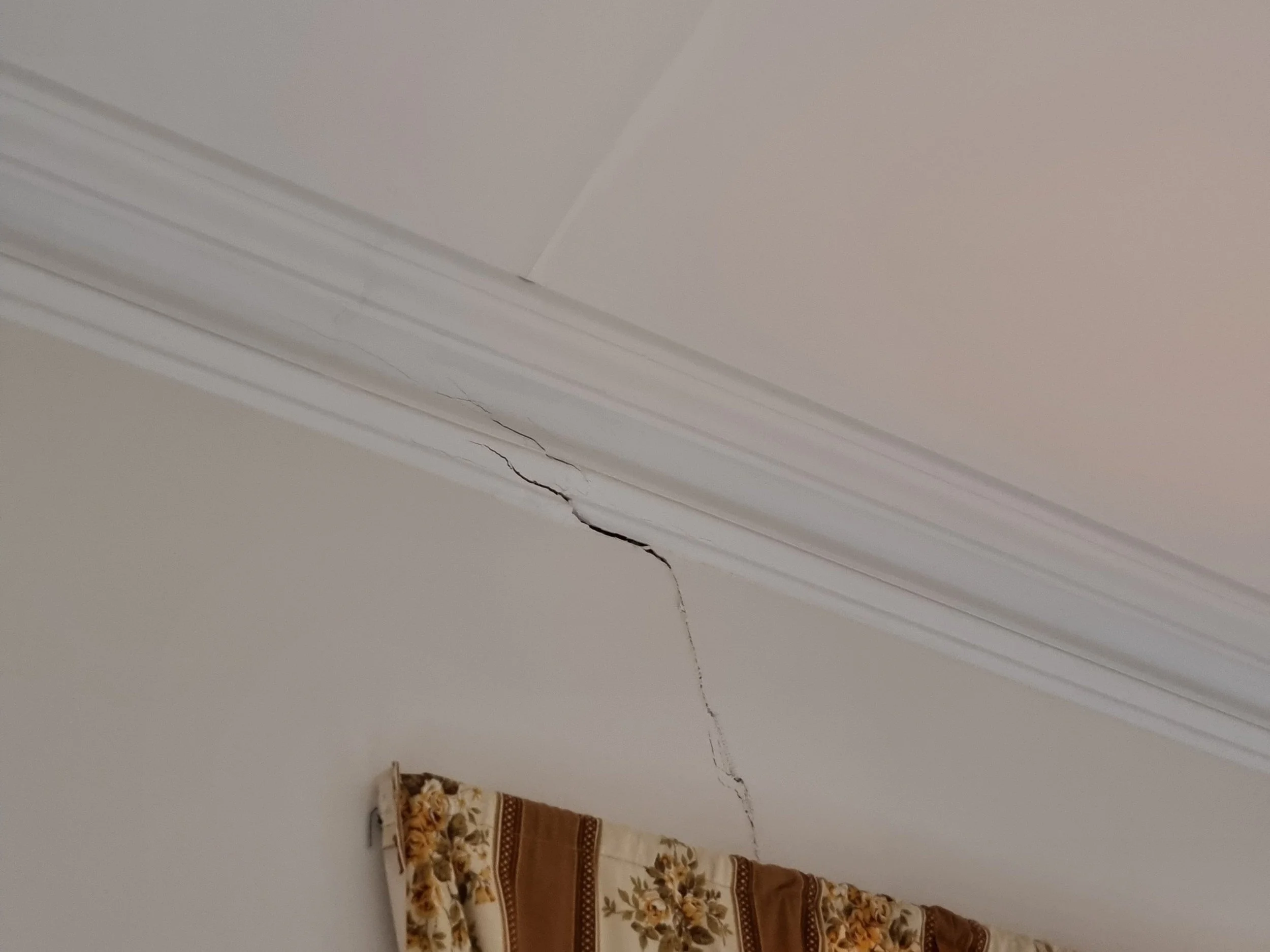Why is my cornice cracking?
Have you ever looked up at your cornices and noticed cracking or sagging? Cornice cracking is a common issue we come across in structural engineering and forensic engineering. In this blog post, we will discuss what cornice cracking is and some of the causes for it.
What is a cornice?
A cornice is a decorative moulding or projection that runs along the top of a wall. The purpose of a cornice is to cover a small gap between walls and ceilings. Melbourne has particularly expansive clayey soil, which would otherwise crush the plaster at the top of walls. Cornices are most commonly made from timber, MDF and plaster. Cornices may also be made from polyurethane or expanded polystyrene.
Cornices come in many different styles. The choice of a cornice design depends on the architectural style of the building and personal preference. Some styles are more susceptible to cracking and movement.
Some of the more common styles of cornices that we see in Australia are:
Classic Cornice: Known by its detailed mouldings, often featuring intricate scrollwork and other decorative elements.
Square Set Cornice: This type of cornice is a simple, straight-lined design that features a boxed frame or box-like structure. The walls and ceilings simply meet at a 90 degree angle.
Stepped Cornice: This cornice design features a series of step-like mouldings. These mouldings create a visually interesting effect.
Shadowline Cornice: This cornice is like a square set cornice. But instead, the top of the wall is recessed slightly.
Cove Cornice: A cove cornice is a simple curved shape that is often found in more modern and contemporary architecture. If your house was built in the last 50 years, it probably contains this.
Image of cracks in a cornice, continues above and below window.
Image supplied by Arbiter Group.
So what causes a cornice to crack?
Cornice cracking and damage can be caused by many different reasons. Let's discuss six of the most common causes of cornice cracking.
Moisture
Moisture in a home is one of the leading causes of cornice cracking. There could be a few reasons for moisture entering the home, however, a plumbing leak is the most common cause. When moisture enters the home, it can be absorbed by the materials in the ceiling, causing them to expand. When the moisture evaporates, the materials can contract again. This can lead to stress on the cornice joints and ultimately cause cracks. Additionally, if moisture accumulates in the ceiling, it can cause the materials to weaken and become more prone to cracking under stress.
Another major concern is if moisture enters the property for prolonged periods of time and goes undetected, it could lead to mould growth in the ceiling. The resulting pressure can also cause cracks in the cornice.
Temperature changes
Temperature changes in a home can cause a cornice to crack in a couple of ways. When there are significant fluctuations in temperature, the materials in the ceiling can expand and contract, leading to stress on the cornice joints. For example, if the temperature outside drops rapidly, the materials in the ceiling can contract quickly. If the cornice is not able to handle the stress, it may crack.
Additionally, if the temperature in the home is not properly regulated, it can lead to condensation and the accumulation of moisture in the ceiling. This, in turn, can weaken the materials and make them more prone to cracking under stress.
Although temperature changes provide minimal effects, cornices are the easiest elements of a dwelling to crack and separate.
Age and wear
Over time, the materials in the ceiling and cornice can also deteriorate due to:
normal wear and tear,
exposure to sunlight, and
other environmental factors
This can make the materials weaker and more prone to cracking under stress.
If the house has not been properly maintained, it can also lead to stress on the cornice joints and eventual cracking. This can be due to neglecting to repair leaks or not addressing other structural issues. Age and wear in a home can cause the materials in the ceiling and cornice to weaken, making them more susceptible to cracking under stress.
Image of cracks in a cornice, above a window.
Image supplied by Arbiter Group.
Structural issues and movement
Structural issues and movement are also some major culprits for cornice cracking. All properties will be subject to some degree of movement as a house settles over time. The structure can shift slightly, causing stress on the cornice joints and resulting in cracks.
There are several issues that cause footing movement and this can affect the cornices in several ways. Footing movement refers to the shifting or settling of a building's foundation, which can cause the entire structure to move and shift over time. This movement can put stress on the cornice, causing it to crack.
Some structural issues and construction defects can also cause this damage. But they are too specific to go into detail in this blog post.
Improper installation
Improper installation of cornices can cause them to crack in several ways:
Inadequate support: Cornices are designed to be supported by a solid backing. If the cornice is not properly supported, it may not be able to withstand the weight it was designed to support, leading to cracks.
Poor adhesion: If the cornice is not properly adhered to the backing, it may separate from the wall, causing cracks to form.
Incorrect spacing: If the cornice is not spaced correctly, it may put undue stress on certain areas, causing cracks to form.
Improper joint placement: If the joints in the cornice are not properly placed, it can cause stress points, which can lead to cracks over time.
Use of inferior materials: If inferior or substandard materials are used in the installation of the cornice, it may not be able to withstand the weight it was designed to support, leading to cracks.
Inaccurate measurement: If the cornice is not measured and cut to the correct size, it may not fit properly, causing stress points and cracks to form.
Square set cornices are a popular choice that homeowners have chosen to use in recent years. This is usually because of its modern and architectural appeal but it is by far the most susceptible to cracking due to installation issues. Our Engineers do not recommend square set cornices unless your property is located on an area of class A or S soil. Any other soil conditions would not be suitable for this style of cornice and will be much more likely to cause cracking. There are not many places in Melbourne that contain this type of soil. So it is a good idea to avoid square set cornices where possible.
Impact damage
Impact damage can cause cornice cracking by placing sudden and forceful pressure on the cornice. While they are not designed to bear any significant weight or support the structure of the building, cornices are exposed to a variety of external forces, including impact damage.
Impact damage can be caused by several factors, including:
falling debris,
heavy winds,
physical impact from vehicles or equipment,
stepping on the ceilings rather than the framing when traversing the roof space
When a cornice is struck by an object, the sudden force can cause it to crack or even break away from the building's exterior wall. Even if the initial impact does not cause immediate damage, it can weaken the structure of the cornice, making it more susceptible to cracking or breaking in the future.
Image of cracks in a cornice and wall below it.
Image supplied by Arbiter Group.
How can Arbiter Group help you?
Although cornice cracking is not harmful by itself, it can be a sign of much larger problems, such as structural damage or plumbing leaks. If you’ve noticed cornice cracking in your home, a structural engineer that specialises in forensic engineering can give you peace of mind. At Arbiter Group, our structural engineers specialise in forensic engineering and have inspected many properties with cornice cracking. Our engineering report findings have ranged from minor joint separation to more sinister structural issues. Our engineering reports help you to gain an understanding of the causes behind cornice cracking and provide recommendations for repair by suitable trades. Contact Arbiter Group today to discuss your needs and see how we can help you.




